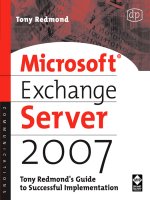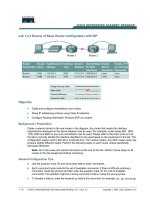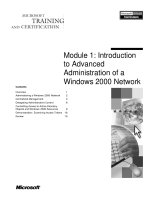Tài liệu Panda3D 1. 6 Game Engine Beginner''''s Guide by Dave Mathews doc
Bạn đang xem bản rút gọn của tài liệu. Xem và tải ngay bản đầy đủ của tài liệu tại đây (5.93 MB, 356 trang )
www.it-ebooks.info
Panda3D 1.6 Game Engine
Beginner's Guide
Create your own computer game with this 3D rendering and
game development framework
David Brian Mathews
www.it-ebooks.info
Panda3D 1.6 Game Engine
Beginner's Guide
Copyright © 2011 Packt Publishing
All rights reserved. No part of this book may be reproduced, stored in a retrieval system,
or transmitted in any form or by any means, without the prior written permission of the
publisher, except in the case of brief quotations embedded in critical articles or reviews.
Every effort has been made in the preparation of this book to ensure the accuracy of the
information presented. However, the information contained in this book is sold without
warranty, either express or implied. Neither the author, nor Packt Publishing, and its dealers
and distributors will be held liable for any damages caused or alleged to be caused directly or
indirectly by this book.
Packt Publishing has endeavored to provide trademark information about all of the
companies and products mentioned in this book by the appropriate use of capitals. However,
Packt Publishing cannot guarantee the accuracy of this information.
First published: February 2011
Production Reference: 1040211
Published by Packt Publishing Ltd.
32 Lincoln Road
Olton
Birmingham, B27 6PA, UK.
ISBN 978-1-849512-72-5
www.packtpub.com
Cover Image by Charwak A ()
www.it-ebooks.info
Credits
Author
Editorial Team Leader
David Brian Mathews
Reviewers
Project Team Leader
Paulo Barbeiro Ferreira
Joni Hariyanto
Zainab Bagasrawala
Usha Iyer
Joel Goveya
Development Editor
Proofreaders
Reshma Sundaresan
Aaron Nash
Jonathan Todd
Technical Editors
Arun Nadar
Graphics
Manasi Poonthottam
Hemangini Bari
Ashwin Shetty
Project Coordinators
Acquisition Editor
Indexer
Mithun Sehgal
Nilesh R. Mohite
Production Coordinator
Kruthika Bangera
Cover Work
Kruthika Bangera
www.it-ebooks.info
About the Author
David Brian Mathews is a graduate in Electronic Visualization program from the
University of Illinois at Chicago. He began programming in the fifth grade with QBASIC
and has been designing games of various kinds, from table-top board games to computer
games, since childhood. Prior to entering higher education, he served for two years in the
United States Navy as a nuclear engineer before being honorably discharged for medical
reasons, where he learned discipline, advanced mathematics, and nuclear theory, as well
as teamwork and leadership skills. During his years in school, Mathews earned valuable
experience with professional game development methods working both by himself and
with teams. He is skilled at programming, 3D modeling and animation, drawing, and 2D
compositing.
I'd like to thank my friends and family, who have been immensely
supportive of me throughout the writing of this book. In particular, I'd like
to thank my mother, Carol Malley, and my friends Jeff Fuja and William
Hebert for all their efforts and sacrifices on my behalf.
www.it-ebooks.info
About the Reviewers
Paulo Barbeiro Ferreira is Brazilian, from São Paulo, and graduated in Graphic Design
in 2004 at Belas Artes SP college. He is a postgraduate in Game Development at SENAC SP.
Paulo started his professional career in 1999 as a web developer.
Today, besides the web and mobile application development work, Paulo is involved in
experimental educational projects in technology and cyber culture at SESC SP, where he
leads activities about creative code and art software, such as interactive environments,
games, and entertainment media.
Joni Hariyanto graduated from the Engineering Faculty of Brawijaya University a few years
ago. Now, he works as a freelance architect.
Actually, he's just a hobbyist in the computer science world. He has been programming since
first grade junior high in languages including Pascal, Python, and C++.
Bored with the never changing architectural visualization teaching materials at uni, he
wandered on the Internet searching for a way to get unlimited control over visualization, for
the sake of design clarity and without sacrificing too much time in the "post-design" phase;
that is, rendering the gazillion frames.
He stumbled upon Panda3D in 2005, a free 3D game engine, which makes perfect balance of
power, flexibility, and handling (from programmer's point of view). Liked it, melted with it in
no time, thanks to Python.
www.it-ebooks.info
www.PacktPub.com
Support files, eBooks, discount offers, and more
You might want to visit www.PacktPub.com for support files and downloads related to your
book.
Did you know that Packt offers eBook versions of every book published, with PDF and ePub
files available? You can upgrade to the eBook version at www.PacktPub.com and as a print
book customer, you are entitled to a discount on the eBook copy. Get in touch with us at
for more details.
At www.PacktPub.com, you can also read a collection of free technical articles, sign up for a
range of free newsletters and receive exclusive discounts and offers on Packt books and eBooks.
Do you need instant solutions to your IT questions? PacktLib is Packt's online digital book
library. Here, you can access, read and search across Packt's entire library of books.
Why Subscribe?
Fully searchable across every book published by Packt
Copy and paste, print, and bookmark content
On demand and accessible via web browser
Free Access for Packt account holders
If you have an account with Packt at www.PacktPub.com, you can use this to access
PacktLib today and view nine entirely free books. Simply use your login credentials for
immediate access.
www.it-ebooks.info
Table of Contents
Preface
Chapter 1: Installing Panda3D and Preparing a Workspace
Getting started with Panda3D installation packages
Time for action – downloading and installing Panda3D
Switching to an advanced text editor
Time for action – downloading and installing Notepad++
Installing the game content
Time for action – demoing Suicide Jockeys
Installing optional tools
Blender and Chicken
Spacescape
Explosion Texture Generator
Summary
1
7
8
8
11
11
13
13
14
15
16
16
17
Chapter 2: Creating the Universe: Loading Terrain
19
Notepad++
Setting up a new file in Notepad++
Time for action – setting up a new file in Notepad++
Importing Panda3D components
Time for action – importing DirectStart
Creating a World Object
Time for action – creating a World Object
Loading the terrain
Time for action – loading the terrain
Loading files into Panda3D
The model path
Eggs
Bams
NodePaths and nodes
20
20
20
21
21
22
23
27
28
30
30
30
32
32
www.it-ebooks.info
Table of Contents
Time for action – introducing NodePaths and nodes
Manipulating NodePaths
Time for action – manipulating NodePaths
The Scene Graph
Time for action – understanding parent child inheritance
Time for action – explaining relative coordinate systems
Loading a file multiple times
Render attributes
Time for action – demonstrating render attributes
Summary
Chapter 3: Managing Tasks Over Time
33
35
36
37
38
40
41
41
43
46
47
The task manager
Time for action – printing the task list from the task manager
Avoiding multiple task managers
Adding tasks to the task manager
Time for action – creating a task and adding it to the task manager
Time for action – looking at task statistics
Adding a delay to tasks
Time for action – using doMethodLater
Using delta time
Time for action – using delta time
Over viewing task return options
About the None type object
Time for action – exploring task return options
Prioritizing tasks
Removing tasks from the task manager
Time for action – removing tasks by name
Dissecting task objects
Summary
Chapter 4: Taking Control: Events and User Input
Working with events
Time for action – registering and responding to events
Using keyboard events
Using a key map
Time for action – creating and using a key map
Implementing advanced cycle controls
Time for action – implementing acceleration
Time for action – implementing throttle control
Time for action – implementing turning
Utilizing mouse input and creating camera control
[ ii ]
www.it-ebooks.info
48
48
49
49
50
52
54
54
55
56
57
58
58
61
61
62
64
65
67
67
68
70
71
72
75
75
78
80
82
Table of Contents
Time for action – tying the camera to the cycle
Reacting to mouse movement
Time for action – turning the camera with the mouse position
Ending event response
Summary
Chapter 5: Handling Large Programs with Custom Classes
82
84
85
86
87
89
Importing custom classes
Time for action – making and importing a custom class
Adding NodePath functionality to a custom class
Time for action – defining the Cycle class
Simulating drift
Time for action – simulating drift
Accessing classes from within another class
Time for action – adding an input manager
Summary
89
90
93
93
97
97
103
103
107
Chapter 6: The World in Action: Handling Collisions
109
Collision basics: Our first collision system
Time for action – creating a simple collision detection system
Creating inter-cycle collisions
Time for action – inter-cycle collisions
Using BitMasks to organize collisions
Time for action – implementing BitMasks
Time for action – setting a range of bits with BitMask.range
Using Python tags to get colliding objects
Time for action – setting and getting PythonTags
Setting up ground collision
Time for action – creating a ground collision system
Overview of additional collision solids and handlers
Collision solids
Collision handlers
Summary
Chapter 7: Making it Fancy: Lighting, Textures, Filters, and Shaders
Adding lighting
Time for action – adding lights to the game
Types of lights
Applying textures to models
Time for action – creating a bam writer
Texture stages
Time for action – using TextureStages
Creating filters
[ iii ]
www.it-ebooks.info
109
110
116
116
122
123
124
126
126
128
128
142
142
144
144
145
145
146
149
150
151
154
156
161
Table of Contents
Time for action – adding a bloom filter
Using a sky sphere
Time for action – adding a sky sphere
Summary
161
164
164
167
Chapter 8: GUI Goodness: All About the Graphic User Interface
Creating a menu system
About DirectGUI
Time for action – creating a menu system
Putting menus to use
Time for action – using menus
In-game HUD
Time for action – creating a basic HUD
Summary
Chapter 9: Animating in Panda3D
169
169
170
171
187
188
195
196
203
205
Actors and Animations
Time for action – loading Actors and Animations
Controlling animations
Animation blending
Time for action – blending two animations
Creating and using Actor subparts
Time for action – playing animations on subparts
Exposing joints
Time for action – animating our cycles
Summary
Chapter 10: Creating Weaponry: Using Mouse Picking and Intervals
Using mouse picking
Time for action – setting up mouse aim
Understanding Intervals, Sequences, and Parallels
Sequences and Parallels
Creating machine guns
Time for action – using Intervals in Sequences and Parallels
Time for action – adding collision detection to the MachineGun
Implementing the main cannon
Time for action – creating the main cannon
Adding weapon information to the HUD
Time for action – adding a new HUD section
Handling damage response
Time for action – finalizing weapons with damage response
Summary
[ iv ]
www.it-ebooks.info
205
206
208
209
209
211
213
214
215
219
221
221
222
225
228
229
229
235
238
238
242
243
247
247
251
Table of Contents
Chapter 11: What's that Noise? Using Sound
Editing Config.prc
Time for action – selecting an audio library
Adding music
AudioSound objects
AudioManager objects
Time for action – creating background music
Adding sound effects
Time for action – generating 3D audio with Audio3DManager
About sound intervals
Summary
Chapter 12: Finishing Touches: Getting the Game Ready for the Customer
Collecting garbage
Time for action – collecting garbage from the Explosion classes
Time for action – collecting garbage from the Gun classes
Time for action – collecting garbage from the Cycle class
Time for action – collecting garbage from the Track class
Creating a preloader
Time for action – creating a preloader to load models
File handling
Time for action – reading data from a file
Customizing the mouse cursor
Time for action – customizing the mouse cursor
Creating an Installer
Time for action – packing a Panda3D game
Summary
Appendix A: Creating a Sky Sphere with Spacescape
Learning Spacescape basics
Time for action – getting started with Spacescape
Blending layers
Time for action – blending layers to create nebulas
Using point stars and billboard stars
Time for action – populating the sky with stars
Creating a sky sphere from a skybox made with Spacescape
Time for action – populating the sky with stars
Time for action – creating the sky sphere in Panda3D
Summary
253
253
254
254
254
256
257
258
258
263
264
265
265
267
269
270
272
273
273
276
277
278
279
282
282
285
287
288
289
292
294
297
297
302
302
303
305
Appendix B: Using Egg-Texture-Cards and ExploTexGen
307
Using ExploTexGen
Time for action – reading the ExploTexGen documentation
308
308
[v]
www.it-ebooks.info
Table of Contents
Time for action – designing an explosion
Creating flipbook animations with egg-texture-cards
Time for action – using egg-texture-cards
Additional egg-texture-card options
Summary
Appendix C: Pop quiz Answers
310
313
313
314
315
317
Chapter 2: Creating the Universe: Loading Terrain
Starting Panda3D and loading models
Using NodePath and understanding scene graph inheritance
Chapter 3: Managing Tasks Over Time
The task manager
Delta time
Task return options
Chapter 4: Taking Control: Events and User Input
Working with events
Using keyboard input
Utilizing mouse input
Chapter 5: Handling Large Programs with Custom Classes
Importing custom classes
Accessing custom classes from other classes
Chapter 6: The World in Action: Handling Collisions
Regarding basic collision detection
Understanding handlers that generate events
Understanding BitMasks
Using Python tags
Complex collision detection
Chapter 7: Making it Fancy: Lighting, Textures, Filters, and Shaders
Using lights
Understanding textures and TextureStages
Setting up a sky sphere
Chapter 8: GUI Goodness: All About the Graphic User Interface
Understanding DirectGUI
Creating a Heads Up Display
Chapter 9: Animating in Panda3D
Animation basics
Advanced animation
Chapter 10: Creating Weaponry: Using Mouse Picking and Intervals
Mouse picking
Intervals
[ vi ]
www.it-ebooks.info
317
317
318
318
318
318
318
319
319
319
319
319
319
320
320
320
320
321
321
321
322
322
322
322
323
323
323
323
323
323
324
324
324
Table of Contents
Chapter 11: What's that Noise? Using Sound
Making music
Sounding off
Chapter 12: Finishing Touches: Getting the Game Ready for the Customer
Garbage collection
Using a custom mouse cursor
Building an installer
Index
325
325
325
325
325
326
326
327
[ vii ]
www.it-ebooks.info
www.it-ebooks.info
Preface
Panda3D is a game engine, a framework for 3D rendering and game development for
Python and C++ programs. It includes graphics, audio, I/O, collision detection, and other
abilities relevant to the creation of 3D games. Also, Panda3D is Open Source and free for
any purpose, including commercial ventures. This book will enable you to create finished,
marketable computer games using Panda3D and other entirely open source tools, and then
sell those games without paying a cent for licensing.
Panda3D 1.6 Game Engine Beginner's Guide follows a logical progression from a zero start
through the game development process all the way to a finished, packaged installer. Packed
with examples and detailed tutorials in every section, it teaches the reader through firsthand experience. These tutorials are followed by explanations that describe what happened
in the tutorial and why.
You will start by setting up a workspace, and then move on to the basics of starting up
Panda3D. From there, you will begin adding objects such as a level and a character to the
world inside Panda3D. Then, the book will teach you to put the game's player in control by
adding changes over time and responses to user input. Then, you will learn how to make it
possible for objects in the world to interact with each other by using collision detection and
beautify your game with Panda3D's built-in filters, shaders, and texturing. Finally, you will
add an interface, audio, and package it all up for the customer.
This is a simple but detailed guide to using Panda3D, which will take you from a blank text
file all the way through the Python programming process to a finished game with a single
level, including such topics as handling tasks over time, event handling and response,
collision set up and detection, audio, and more.
www.it-ebooks.info
Preface
Who this book is for
This book is targeted at independent developers who are interested in creating their own
video games or other 3D applications for personal or commercial distribution at minimal
expense. A basic understanding of general programming, such as knowing what a variable is,
is necessary. Some familiarity with object-oriented programming and the Python language is
expected, but not required.
Development teams who are interested in using Panda3D for production of 3D applications or
video games would also find this book useful for training team members in the use of Panda3D.
This book does not cover the creation of three-dimensional models or similar art assets, nor
does it cover the creation of two-dimensional art assets or audio assets.
What this book covers
Chapter 1, Installing Panda3D and Preparing a Workspace guides the reader through
downloading and installing Panda3D and Notepad++ (an open source text editor) as well
as acquiring assets provided with the book (from CD or website) and setting up the file
structure for that content using Windows Explorer.
Chapter 2, Creating the Universe: Loading Terrain is the reader's first opportunity to get their
hands dirty with some coding. It will take them from a blank file to a simple program that will
load up a terrain model and introduce related basic concepts.
Chapter 3, Managing Tasks Over Time introduces the reader with tasks, the task manager,
and controlling processes that need to occur over time or in an ongoing manner.
Chapter 4, Taking Control: Events and User Input focuses on creating user controls for the
game. Keyboard, mouse click, and mouse movement response will be covered. Camera
control will be integrated with handling mouse input.
Chapter 5, Handling Large Programs with Custom Classes; as the game has grown larger, the
time has come to show the reader how to break it apart into custom classes.
Chapter 6, The World in Action: Handling Collisions will focus on making the reader
comfortable with collision detection and the different collision event handlers. Collisions are
vital to a working game and their use is one of the hottest topics on the Panda3D forums.
Chapter 7, Making it Fancy: Lighting, Textures, Filters, and Shaders will explain textures
and the built-in shaders available in Panda3D while allowing the reader to apply lighting,
textures, filters, and shaders to the world and the characters in it.
Chapter 8, GUI Goodness: All About the Graphic User Interface takes the reader through the
production of the game's GUI, including the HUD that displays during game play, the start
menu, and other bits and pieces.
[2]
www.it-ebooks.info
Preface
Chapter 9, Animating in Panda3D; here the reader will replace the static models of hover
cycles with actors and learn all about actor animation and joint manipulation.
Chapter 10, Creating Weaponry: Mouse Picking and Intervals focuses on using intervals to
create weapons and their controls and describes how sequences and parallels can be used to
create interval scripts.
Chapter 11, What's that Noise? Using Sound; here with the game nearly complete, it's time to
introduce some sound effects and background music to bring the game to life. This chapter also
introduces editing the config.prc file to change the audio library Panda3D uses.
Chapter 12, Finishing Touches: Getting the Game Ready for the Customer is the final chapter
of the guide and focuses on some important functions for Panda3D-based games, including
saving and loading files, garbage collection, and packing the game into a standalone package
ready for shipping.
Appendix A, Creating a Sky Sphere with Spacescape teaches the reader how to use the freely
available software Spacescape to create engaging backdrops for Panda3D applications.
Appendix B, Using Egg-Texture-Cards and ExploTexGen; here the reader learns how to create
explosion animations with the freely available software ExploTexGen and learns to turn them
into Panda3D assets with the Egg-Texture-Cards command-line utility.
What you need for this book
Panda3D 1.6, Notepad++, and Python.
Conventions
In this book, you will find several headings appearing frequently.
To give clear instructions of how to complete a procedure or task, we use:
Time for action – heading
1.
Action 1
2.
Action 2
3.
Action 3
[3]
www.it-ebooks.info
Preface
Instructions often need some extra explanation so that they make sense, so they are
followed with:
What just happened?
This heading explains the working of tasks or instructions that you have just completed.
You will also find some other learning aids in the book, including:
Pop quiz – heading
These are short multiple choice questions intended to help you test your own understanding.
Have a go hero – heading
These set practical challenges and give you ideas for experimenting with what you have
learned.
You will also find a number of styles of text that distinguish between different kinds of
information. Here are some examples of these styles, and explanations of their meanings.
Code words in text are shown as follows: "The event name we give to the accept() method
is a string that serves as an identifier for the unique event we want to respond to."
A block of code is set as follows:
if(self.keyMap["d"] == True):
self.turn("r", dt)
elif(self.keyMap["a"] == True):
self.turn("l", dt)
When we wish to draw your attention to a particular part of a code block, the relevant lines
or items are set in bold:
self.menuGraphics = loader.loadModel(
"../Models/MenuGraphics.egg")
self.fonts = {
"silver" : loader.loadFont("../Fonts/LuconSilver.egg"),
"blue" : loader.loadFont("../Fonts/LuconBlue.egg"),
"orange" : loader.loadFont("../Fonts/LuconOrange.egg")}
New terms and important words are shown in bold. Words that you see on the screen, in
menus or dialog boxes for example, appear in the text like this: "Now we see an entry for the
Cycle Move task in the sleep column".
[4]
www.it-ebooks.info
Preface
Warnings or important notes appear in a box like this.
Tips and tricks appear like this.
Reader feedback
Feedback from our readers is always welcome. Let us know what you think about this
book—what you liked or may have disliked. Reader feedback is important for us to
develop titles that you really get the most out of.
To send us general feedback, simply send an e-mail to , and
mention the book title via the subject of your message.
If there is a book that you need and would like to see us publish, please send us a note in the
SUGGEST A TITLE form on www.packtpub.com or e-mail
If there is a topic that you have expertise in and you are interested in either writing or
contributing to a book, see our author guide on www.packtpub.com/authors.
Customer support
Now that you are the proud owner of a Packt book, we have a number of things to help you
to get the most from your purchase.
Downloading the example code for this book
You can download the example code files for all Packt books you have purchased
from your account at . If you purchased this
book elsewhere, you can visit and
register to have the files e-mailed directly to you.
Downloading the color images of this book
We also provide you a PDF file that has color images of the screenshots used in
this book. The color images will help you better understand the changes in the
output. You can download this file from />sites/default/files/2725_images.pdf
[5]
www.it-ebooks.info
Preface
Errata
Although we have taken every care to ensure the accuracy of our content, mistakes do
happen. If you find a mistake in one of our books—maybe a mistake in the text or the
code—we would be grateful if you would report this to us. By doing so, you can save other
readers from frustration and help us improve subsequent versions of this book. If you
find any errata, please report them by visiting http,//www.packtpub.com/support,
selecting your book, clicking on the errata submission form link, and entering the details
of your errata. Once your errata are verified, your submission will be accepted and the
errata will be uploaded on our website, or added to any list of existing errata, under the
Errata section of that title. Any existing errata can be viewed by selecting your title from
http,//www.packtpub.com/support.
Piracy
Piracy of copyright material on the Internet is an ongoing problem across all media. At Packt
Publishing, we take the protection of our copyright and licenses very seriously. If you come
across any illegal copies of our works, in any form, on the Internet, please provide us with
the location address or website name immediately so that we can pursue a remedy.
Please contact us at with a link to the suspected pirated material.
We appreciate your help in protecting our authors, and our ability to bring you valuable content.
Questions
You can contact us at if you are having a problem with any
aspect of the book, and we will do our best to address it.
[6]
www.it-ebooks.info
1
Installing Panda3D and Preparing
a Workspace
It's time to take the first big step. In this chapter we're going to acquire
Panda3D and get our work environment set up. Once we have all that done,
we're going to take a look at the game we'll be creating over the course of this
book.
In this chapter we shall:
Download and install Panda3D
Download and install Notepad++
Install all of the content necessary for the game
Demo the game we'll be creating
Install any optional tools desired
Blender and Chicken
Spacescape
Explosion Texture Generator
There's no time to waste, so let's get cracking!
www.it-ebooks.info
Installing Panda3D and Preparing a Workspace
Getting started with Panda3D installation packages
The kind folks who produce Panda3D have made it very easy to get Panda3D up and working.
You don't need to worry about any compiling, library linking, or other difficult, multi-step
processes. The Panda3D website provides executable files that take care of all the work for
you. These files even install the version of Python they need to operate correctly, so you
don't need to go elsewhere for it.
Time for action – downloading and installing Panda3D
I know what you're thinking: "Less talk, more action!" Here are the step-by-step instructions
for installing Panda3D:
1.
Navigate your web browser to www.Panda3D.org.
2.
Under the Downloads option, you'll see a link labeled SDK. Click it.
3.
If you are using Windows, scroll down this page you'll find a section titled Download
other versions. This book is written for Panda3D version 1.6.2, which is the most
current stable version at the time of writing. Find the link to Panda3D SDK 1.6.2
and click it. If you aren't using Windows, click on the platform you are using (Mac,
Linux, or any other OS.). That will take you to a page that has the downloads for that
platform. Scroll down to the Download other versions section and find the link to
Panda3D SDK 1.6.2, as before.
4.
When the download is complete, run the file and this screen will pop up:
[8]
www.it-ebooks.info
Chapter 1
5.
Click Next to continue and then accept the terms. After that, you'll be prompted
about where you want to install Panda3D.
[9]
www.it-ebooks.info
Installing Panda3D and Preparing a Workspace
6.
The default location is just fine. Click the Install button to continue. Wait for the
progress bar to fill up. When it's done, you'll see another prompt.
7.
This step really isn't necessary. Just click No and move on.
8.
When you have finished the installation, you can verify that it's working by going
to Start Menu | All Programs | Panda3D 1.6.2 | Sample Programs | Ball in Maze
| Run Ball in Maze. A window will open, showing the Ball in Maze sample game,
where you tilt a maze to make a ball roll around while trying to avoid the holes.
[ 10 ]
www.it-ebooks.info









